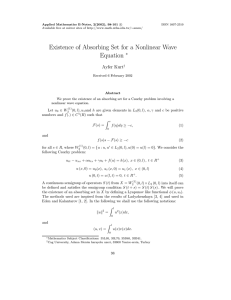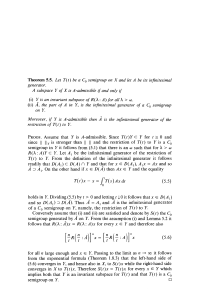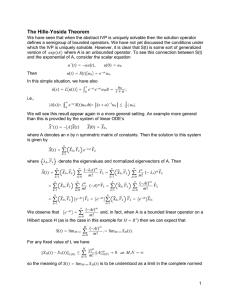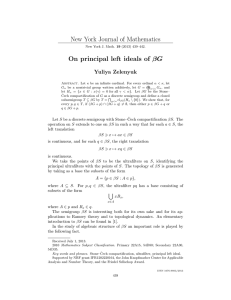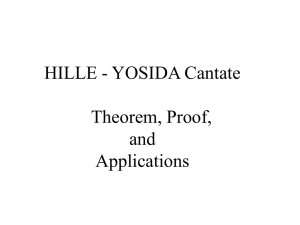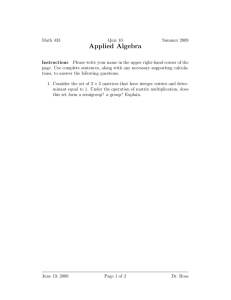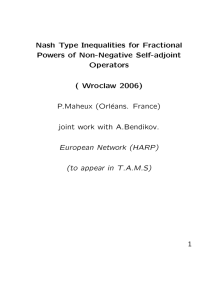SEMIGROUP THEORY APPLIED TO OPTIONS
advertisement
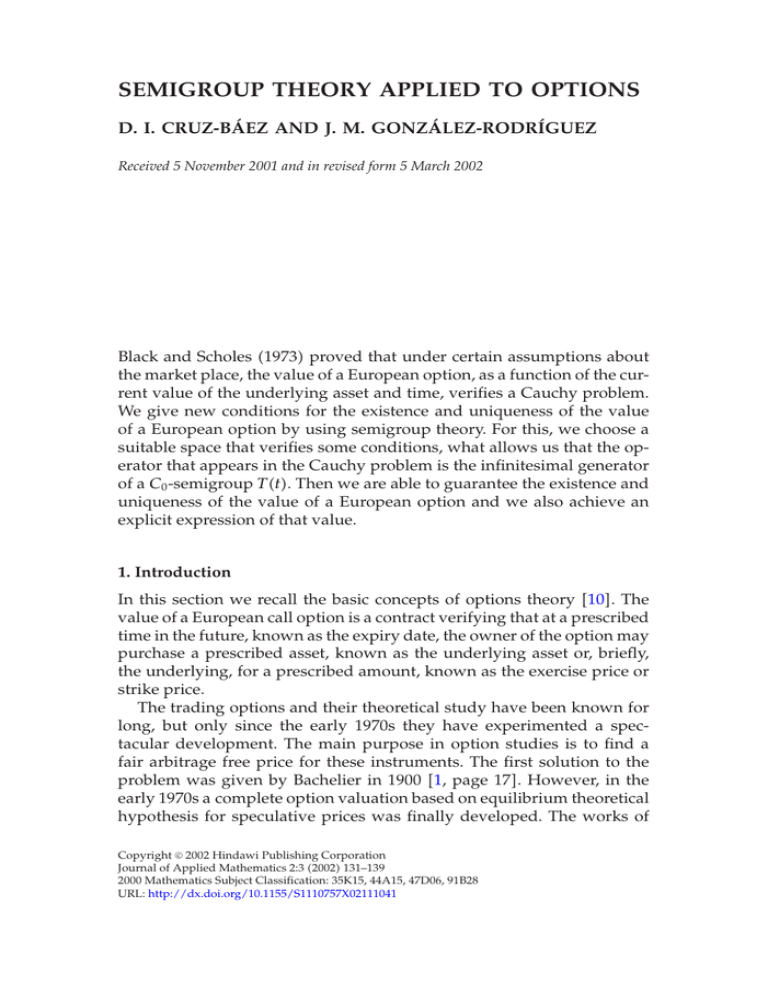
SEMIGROUP THEORY APPLIED TO OPTIONS
D. I. CRUZ-BÁEZ AND J. M. GONZÁLEZ-RODRÍGUEZ
Received 5 November 2001 and in revised form 5 March 2002
Black and Scholes (1973) proved that under certain assumptions about
the market place, the value of a European option, as a function of the current value of the underlying asset and time, verifies a Cauchy problem.
We give new conditions for the existence and uniqueness of the value
of a European option by using semigroup theory. For this, we choose a
suitable space that verifies some conditions, what allows us that the operator that appears in the Cauchy problem is the infinitesimal generator
of a C0 -semigroup T (t). Then we are able to guarantee the existence and
uniqueness of the value of a European option and we also achieve an
explicit expression of that value.
1. Introduction
In this section we recall the basic concepts of options theory [10]. The
value of a European call option is a contract verifying that at a prescribed
time in the future, known as the expiry date, the owner of the option may
purchase a prescribed asset, known as the underlying asset or, briefly,
the underlying, for a prescribed amount, known as the exercise price or
strike price.
The trading options and their theoretical study have been known for
long, but only since the early 1970s they have experimented a spectacular development. The main purpose in option studies is to find a
fair arbitrage free price for these instruments. The first solution to the
problem was given by Bachelier in 1900 [1, page 17]. However, in the
early 1970s a complete option valuation based on equilibrium theoretical
hypothesis for speculative prices was finally developed. The works of
Copyright c 2002 Hindawi Publishing Corporation
Journal of Applied Mathematics 2:3 (2002) 131–139
2000 Mathematics Subject Classification: 35K15, 44A15, 47D06, 91B28
URL: http://dx.doi.org/10.1155/S1110757X02111041
132
Semigroup theory applied to options
Black and Scholes [3] and Merton [7] were the culmination of this great
effort.
In [3], Black and Scholes proved that under certain natural assumptions about the market place, the value of a European option C, as a
function of the current value of the underlying asset, x, and time, t such
that C = C(x, t) verifies the following Cauchy problem:
∂C
∂C 1 2 2 ∂2 C
+ σ x
− rC = 0,
+ rx
2
∂t 2
∂x
∂x
x ≥ 0, t ∈ [0, T ],
(1.1)
with
C(0, t) = 0;
C(x, t) ∼ x
as x −→ ∞;
C(x, T ) = CT = max(x − E, 0),
(1.2)
x ∈ (0, ∞),
where the value of the call option also depends on the volatility of the
underlying asset σ, the exercise price E, the expiry T , and the interest
rate r, where r and σ are constant in this work. Note that the present
study is for stocks without dividends.
An explicit solution for (1.1) and (1.2) can be found in [10]. Moreover,
in [6] some conditions are established for the existence and uniqueness
of the Cauchy problem (1.1) and (1.2), that is,
∂C ∂k C
, k ∈ C (0, ∞) × (0, T ) , k = 0, 1, 2,
∂t ∂x
C(x, t) ∈ C (0, ∞) × [0, T ] ,
C(x, t) ≤ c1 exp c2 (ln x)2 ,
(1.3)
for some c1 , c2 ≥ 0, and where C denotes the continuous functions (see [6,
Chapter 2, Theorem 10] for uniqueness and [6, Chapter 9, Theorem 2] for
existence).
Our purpose is to obtain new conditions that will guarantee the existence and uniqueness of the Cauchy problem (1.1) and (1.2) using the
semigroup theory.
Note that the results that we will obtain are also established for a put
option without more than changing the boundary and final conditions
of the Cauchy problem, that is,
∂P
∂P 1 2 2 ∂2 P
+ σ x
− rP = 0, x ≥ 0, t ∈ [0, T ],
+ rx
∂t 2
∂x
∂x2
P (0, t) = Ee−r(T −t) ;
D. I. Cruz-Báez and J. M. González-Rodríguez
P (x, t) −→ 0
133
as x −→ ∞;
P (x, T ) = max(E − x, 0),
x ∈ (0, ∞).
(1.4)
We recall that for a non-dividend-paying stock, the value of a European call with a certain exercise price and exercise date can be deduced
from the value of a European put with the same exercise price and date,
and vice versa (put-call parity).
The paper is organized as follows. In Section 2, we give an introduction to the semigroup theory, and using this theory, in Section 3 we obtain a theorem for existence and uniqueness, besides getting an explicit
expression of the European option.
2. Semigroup theory
Now, we give an introduction to semigroup theory (see [2, 4, 8]).
Throughout this section X is a Banach space, with norm · .
Definition 2.1. A one-parameter family T (t), 0 ≤ t < ∞, of bounded linear
operators from X into X is a semigroup of bounded linear operator on
X if
(i) T (0) = I, (where I is the identity operator on X);
(ii) T (t + s) = T (t)T (s) for every t, s ≥ 0 (the semigroup property).
A semigroup of bounded linear operators, T (t), is uniformly continuous if
lim T (t) − I = 0.
t→0
(2.1)
From the definition, it is clear that if T (t) is a uniformly continuous semigroup of bounded linear operators, then
lim T (x) − T (t) = 0.
x→t
(2.2)
The linear operator A, defined by
T (t)x − x
exists ,
D(A) = x ∈ X : lim
t→0
t
T (t)x − x d+ T (t)x Ax = lim
=
,
t→0
t
dt t=0
(2.3)
is the infinitesimal generator of the semigroup T (t), D(A) is the domain
of A.
134
Semigroup theory applied to options
Theorem 2.2. A linear operator A is the infinitesimal generator of a uniformly
continuous semigroup if and only if A is a bounded linear operator.
From Definition 2.1, it is clear that a semigroup T (t) has a unique infinitesimal generator. When T (t) is uniformly continuous, its infinitesimal generator is a bounded linear operator.
Definition 2.3. A semigroup T (t), 0 ≤ t < ∞, of bounded linear operators
on X is a strongly continuous semigroup of bounded linear operators if
lim T (t)x = x,
t→0
(2.4)
for every x ∈ X.
A strongly continuous semigroup of bounded linear operators on X
will be called a semigroup of class C0 or simply a C0 -semigroup.
Now, we recall that if A is a linear, not necessarily bounded, operator
in X, the resolvent set ρ(A) of A is the set of all complex numbers λ for
which λI − A is invertible, that is, (λI − A)−1 is a bounded operator in X.
The family R(λ : A) = (λI − A)−1 , λ ∈ ρ(A), of bounded linear operators
is called the resolvent of A.
The following theorem is very important in what follows and it is
known as Hille-Yosida’s theorem.
Theorem 2.4. A linear (unbounded) operator A is the infinitesimal generator
of a C0 -semigroup of contractions T (t), t ≥ 0, if and only if
(i) A is closed and D(A) = X;
(ii) the resolvent set ρ(A) of A contains R+ and for every λ > 0,
R(λ : A) ≤ 1 .
λ
(2.5)
As a consequence of this theorem we obtain the following corollary.
Corollary 2.5. A linear operator A is the infinitesimal generator of a C0 semigroup satisfying T (t) ≤ ewt if and only if
(i) A is closed and D(A) = X;
(ii) the resolvent set ρ(A) of A contains the ray {λ : Im λ = 0, λ > w} and
for every λ > 0,
R(λ : A) ≤
1
.
λ−w
(2.6)
D. I. Cruz-Báez and J. M. González-Rodríguez
135
The previous results allow us to prove the following theorem especially useful in what follows.
Theorem 2.6. Let A be a densely defined linear operator with a nonempty
resolvent set ρ(A). The initial value
du(t)
= Au(t),
dt
u t0 = x
t > 0,
(x ∈ X)
(2.7)
has a unique solution u(t), which is continuously differentiable on [0, ∞), for
every initial value x ∈ D(A) if and only if A is the infinitesimal generator of a
C0 -semigroup T (t).
3. A European call option
As we have seen in the introduction, the Black-Scholes equation and
boundary conditions for a European call option with value C(x, t) are
1
∂C
∂2 C
∂C
= − σ 2 x2 2 − rx
+ rC,
∂t
2
∂x
∂x
(x, t) ∈ [0, ∞) × (0, T ),
(3.1)
with
C(0, t) = 0;
C(x, t) ∼ x
as x −→ ∞;
C(x, T ) = CT = max(x − E, 0),
(3.2)
x ∈ (0, ∞).
Note that the linear differential operator
∂
∂ 1 2 2 ∂2
+ σ x
−r
− rx
2
∂t 2
∂x
∂x
(3.3)
has a financial interpretation as a measure of the difference between the
return hedged option portfolio (the first two terms) and the return on a
bank deposit (the last two terms).
The main objective, in this section, includes guaranteeing the existence and uniqueness of the solution of (3.1) and (3.2), and, furthermore,
obtaining an exact expression of the solution.
Consider the space X α defined by
X α = f : xα+1 f(x) ∈ C(0, ∞), fα∞ < ∞ ,
where · α∞ is the norm
fα∞ = sup xα+1 f(x).
0≤x<∞
(3.4)
(3.5)
136
Semigroup theory applied to options
The space (X α , · α∞ ) is a Banach space.
We define the operator A : D(A) ⊂ X α → X α such that
df
d2 f
1
+ rf(x)
f(x) −→ (Af)(x) = − σ 2 x2 2 − rx
2
dx
dx
(3.6)
being D(A) = {f ∈ X α : Af ∈ X α }.
Then, we can establish the following result.
Theorem 3.1. The differential operator A is the infinitesimal generator of a
C0 -semigroup T (t).
∞
α+1
Proof. We denote by C∞
f(x) ∈ C∞
0,α (α ∈ R), the space C0,α = {f : x
0 }.
Then we can see that A is a closed operator and D(A) is dense in X α
α
because D(A) contains C∞
0,α which is dense in X .
Therefore we should study the resolvent set ρ(A). We must find a
function g in D(A) such that
(λI − A)g(x) = f(x),
(3.7)
that is,
(λ − r)g(x) + rx
dg 1 2 2 d2 g
+ σ x
= f(x),
dx 2
dx2
(3.8)
that we write in the following way
dg 1 2
1
d 2
+ σ x
g(x) = f(x).
(λ − r)g(x) + r − σ 2 x
2
dx 2
dx
(3.9)
To solve (3.9) we use the Mellin transform, that is,
M g(x) (s) =
∞
xs−1 g(x) dx
(Re s > 0)
(3.10)
0
and we take into account (see [5, (11), page 307]) that
d 2
g(x) (s) = s2 G(s),
M
x
dx
d
M x g(x) (s) = −sG(s),
dx
where G(s) = Mg(s).
(3.11)
D. I. Cruz-Báez and J. M. González-Rodríguez
137
By (3.11), (3.9) transforms to
1
1
(λ − r)G(s) − r − σ 2 sG(s) + σ 2 s2 G(s) = F(s),
2
2
(3.12)
obtaining G(s)
F(s)
− r − (1/2)σ 2 s − r + λ
1
2
= 2 F(s) · 2 σ
s − 2r/σ 2 − 1 s − 2(r − λ)/σ 2
1
2
= 2 F(s) · ,
σ
s − s1 s − s2
G(s) =
(1/2)σ 2 s2
(3.13)
where s1,2 = r/σ 2 − 1/2 ± (r/σ 2 + 1/2)2 − 2λ = α ± β2 − 2λ, being α =
r/σ 2 − 1/2; β = (r/σ 2 + 1/2)2 .
We consider the case r > (1/2)σ 2 , the other case is proved in a similar
way using [5, (9), page 342].
If we apply in (3.13) the inverse Mellin transform, we have by virtue
of [5, (7), page 341]
f(x) ∗ s − s −1 · xs1 − xs2 ,
1
2
g(x) =
0,
0 < x < 1,
1 < x < ∞,
where ∗ represents the Mellin convolution [9], that is,
∞ 1
x
g(y) dy.
f
f ∗ g(x) =
y
y
0
(3.14)
(3.15)
Then, for 0 < y < 1,
g(x) = R(z : A)f
√
√
β2 − 2λ ∞ x 1 −α+ β 2 −2λ
−α− β 2 −2λ
dy.
·
y
f
−
y
= 2
y
y
σ 2λ − β2 0
(3.16)
On the other hand, using (3.16) and making the change of variables
x/y = u gives
138
Semigroup theory applied to options
2 − 2λ β
α+1
1
x g(x) ≤ c1 fα∞
2
2λ − β2
σ
∞ √β2 −2λ
∞ −√β2 −2λ
x
x
−2
−2
· x
u du −
u du ,
u
u
x
x
(3.17)
where c1 is a positive constant.
Thus, evaluating the two integrals we obtain
α+1
x g(x) ≤ c2
1
fα∞ ,
λ − β2 /2
(3.18)
and therefore,
gα∞ ≤ c2
1
fα∞ ,
λ − β2 /2
(3.19)
where c2 is a positive constant and Re λ > β2 /2 = (1/2)(r/σ 2 + 1/2)4 .
Then by Corollary 2.5, A generates a C0 -semigroup T (t), where
T (t)f(x)
1 c+i∞ λx e R(λ : A)f (x) dλ
=
2πi c−i∞
∞
c+i∞
1
λx
e ·
f(u)x−α−1 uα+1
=
2πiσ 2 c−i∞
x
√β2 −2λ −√β2 −2λ
β 2 − 2λ
x
x
x du ·
−
dλ,
u
u
u2
2λ − β2
(3.20)
for Re λ > β2 /2.
By Theorems 2.6 and 3.1, we can guarantee the existence and uniqueness of problem (3.1) with conditions (in this case, C ∈ X α ) different from
those given in [6] and obtain the explicit expression in a way different
from [10, Chapter 5, pages 97–100], that is, we have the following theorem.
D. I. Cruz-Báez and J. M. González-Rodríguez
139
Theorem 3.2. There is a unique solution C(x, t) of (3.1) and (3.2) in the space
X α , and
C(x, t) = T (t)CT .
(3.21)
Acknowledgment
The authors are thankful to the referee for the valuable comments that
led to the improvement of this paper.
References
[1]
[2]
[3]
[4]
[5]
[6]
[7]
[8]
[9]
[10]
L. Bachelier, Theory of speculation, The Random Character of Stock Market
Prices (P. Cootner, ed.), MIT Press, Massachusetts, 1964, pp. 17–78.
A. Belleni-Morante, Applied Semigroups and Evolution Equations, Oxford
Mathematical Monographs, Oxford University Press, New York, 1979.
F. Black and M. Scholes, The pricing of options and corporate liabilities, J. Polit.
Econ. 81 (1973), 637–654.
H. Brézis, M. G. Crandall, and F. Kappel (eds.), Semigroups, Theory and Applications. Vol. II, Pitman Research Notes in Mathematics, vol. 152, Longman
Scientific & Technical, Harlow, 1986.
A. Erdélyi, W. Magnus, F. Oberhettinger, and F. G. Tricomi, Tables of Integral
Transforms. Vol. I, McGraw-Hill, New York, 1954.
A. Friedman, Partial Differential Equations of Parabolic Type, Robert E. Krieger
Publishing, New York, 1983.
R. C. Merton, Theory of rational option pricing, Bell J. Econom. Management
Sci. 4 (1973), 141–183.
A. Pazy, Semigroups of Linear Operators and Applications to Partial Differential
Equations, Applied Mathematical Sciences, vol. 44, Springer-Verlag, New
York, 1983.
I. N. Sneddon, Fourier Transforms, McGraw-Hill, New York, 1951.
P. Wilmott, Paul Wilmott introduces Quantitative Finance, John Wiley & Sons,
New York, 2001.
D. I. Cruz-Báez: Department of Applied Economics, University of La Laguna,
Campus de Guajara, s/n, Edificio de Económicas - Empresariales, 38071 La Laguna
(Tenerife), Spain
E-mail address: dicruz@ull.es
J. M. González-Rodríguez: Department of Applied Economics, University of La
Laguna, Campus de Guajara, s/n, Edificio de Económicas-Empresariales, 38071 La
Laguna (Tenerife), Spain
E-mail address: jomagon@ull.es
